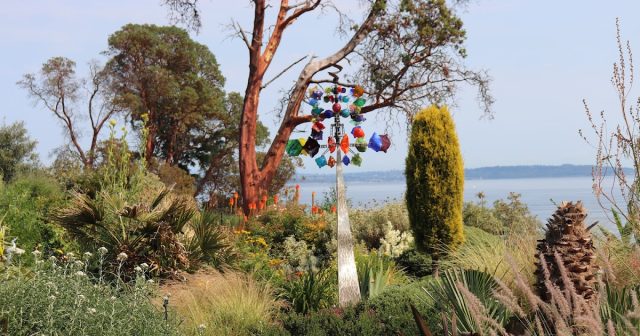The busy season is definitely here! Is it ever! So no in-depth plant dive this week. Rather, a jolly look at all things pretty (at least to me) in the garden. There is plenty happening in the garden, plus a plant sale (more info at the end of this post). Okay, let’s roll!
The top of the berm garden on a lovely sunny spring morning. Ceanothus ‘Blue Jeans’ in the background.
I notice many pretty native plants right now, so I have compiled images of a bunch of them. Here is Vaccinium ovatum ‘Scarlet Ovation’, a small vaccinium with especially vibrant red new leaves.
Two manzanitas at the top of our driveway – Arctostaphylos ‘Harmony’ on the right and A. ‘Pacific Mist’ on the left.
A very pretty ceanothus with an open habit, Ceanothus cuneatus ‘Blue Sierra’. This Willamette Valley native ceanothus has seen no winter damage and has lovely blue-violet flowers.
Another of the same species, Ceanothus c. ‘Adair Village’ is equally as tough although larger and narrower foliage. No winter damage at all on either of these.
Ceanothus ‘Blue Jeans’ is an early bloomer for a ceanothus and has a good compact size of about 6′ x 6′ and can be pruned heavily. Loves the heat, too.
A ground cover California lilac, Ceanothus gloriosus is a lovely evergreen plant that works well for erosion control and to cover larger areas. One plant can be several feet wide. It is quite dense, making it a good option for suppressing weeds.
An update on Baccharis pilularis, coyote bush. There is green in there, as I expected. It is rapidly growing out of its winter-damaged leaves which have mostly fallen to the ground. In a “normal” winter it is evergreen, but not this year. Still, it’s hardy and rebounding beautifully.
Oxalis oregana ‘Klamath Ruby’ has formed thick carpets throughout many shady areas. The undersides of the leaves have a ruby cast to them, as hinted at in this image.
Sedum spathulifolium purpureum and S. s. ‘Cape Blanco’ melting together.
The first flowers of Sildacea campestris or checker mallow are making a show. A very long-blooming plant, it is a favorite of pollinators. It does seed about but it’s in my meadow area, perfect plant in a perfect place.
Here’s a wider shot of the cobweb thistle.
Mahonia nervosa (Berberis nervosa) is naturalized in my woodland garden and is in full bloom right now. Such an easy, pretty plant, about 2′ or so tall.
Our native western maidenhair fern, Adiantum aleuticum, is the cutest thing when unfurling.
The first of the Limnanthes douglasii or Douglas’ meadow foam is blooming. This sweet native annual plant is now all over my garden and I love it. It does form a good mat of foliage that suppresses weeds quite nicely then dies out completely by summer, leaving tons of fabulous seed behind.
I noticed Arctostaphylos ‘Austin Griffiths’ is leaning an arm on Buddha’s shoulder. Seems appropriate somehow.
A few non-native favorites are also looking fine right now. Saxifraga x geum ‘Dentata’ is forming nice patches throughout the shade garden.
Osmanthus delavayi blooming in a lot of shade so its blooms are sparce. Were it in more sun it would bloom much more. Flowers or not, it’s a tough and pretty evergreen shrub for a variety of garden situations.
Ophiopogon ‘Nigrescens’ has been added to several spots in the shade garden recently. I like how it looks with the grey of rocks and gravel.
Lonicera nitida ‘Silver Beauty’, shrubby honeysuckle, in a variegated form. While it does revert back to all green in random branches, a quick prune of the green bits takes care of that.
Hebe ‘Sutherlandii’, the fabulous looks-like-it’s-pruned shrub. It’s not.
Hebe ‘Karo Golden Esk’ in evening light makes it look a little dull, it’s a beautiful hebe with rich green gold tones.
Berberis darwinii, an evergreen barberry, with Oscar in the background.
Geum rivale is a low-spreading geum with curious flowers, usually in shades of orange. This portion features white to pale green flowers.
Veronica armena, though it looks like Veronica ‘Georgia Blue’ a little, is a rock garden plant with needle-like foliage and comes from Turkey and its surrounds.
Afternoon light through Spiraea x vanhouttei ‘Pink Ice’.
The western woodland is starting to wake up. Lonicera nitida ‘Lemon Beauty’ is the evergreen shrub in the center.
Olearia lineata ‘Dartonii’ update – it has completely refoliated after dropping so many leaves following the winter storm in January. It really is super hardy for me. I love Far Reaches Farm’s description of this plant: Intriguing “Shrub Daisy” from the South Island in New Zealand. If you’ve hankered for a willow but lament your dry conditions, then weep no more. All the grace and texture of a small willow with the bonus of small white flowers and deer resistance. Contrast with dark or big foliage.
Acer palmatum ‘Sango Kaku’ has bright fresh foliage right now. I appreciate this small tree in all four seasons.
A columnar apple tree in bloom.
Finally, a reminder I’ll be participating in a plant sale along with several very fabulous plant people this Sunday, April 21, from 11 to 3.
All told I’ll have about 20 flats of plants including many hebes, Ophiopogon ‘Nigrescens’, some PNW natives, Atriplex halimus, a couple Olearia ‘Dartonii’, Lonicera nitida cultivars, Saxifraga ‘Dentata’, some kale starts, sweet pea starts, garden books, seeds, grasses, shade plants, etc. Whew! We’ve been busy. We hope you can stop by and say howdy, there are such great vendors selling everything from houseplants to succulents to trees and ceramics. The address is 334 N. Baldwin St., Portland. Just a bunch of plant enthusiasts offering up some unusual and hard to find treasures to help support our own plant habits. It’s a win-win.
That’s a wrap for this week at Chickadee Gardens. As always thank you so much for reading and commenting, we do love hearing from you! Happy gardening!








































